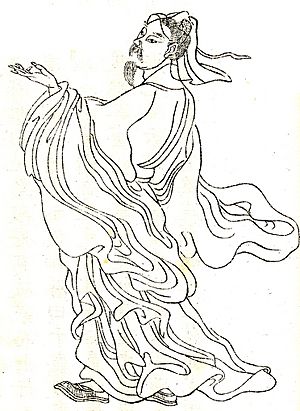Gu Kaizhi facts for kids
Gu Kaizhi (born around 344, died 406) was a very famous Chinese painter and a government official. His courtesy name was Changkang. He is known as one of the greatest painters of ancient China.
Gu Kaizhi was born in Wuxi, a city in China. He started painting in Nanjing in 364. He also worked as a government officer, moving up to higher positions. Besides painting, he was a talented poet and wrote beautifully (calligraphy).
He wrote three important books about how to paint: On Painting, Introduction of Famous Paintings of Wei and Jin Dynasties, and Painting Yuntai Mountain. He believed that in paintings of people, the eyes were the most important part. He said the eyes showed the person's spirit.
Today, we know Gu Kaizhi's art through copies of his silk scroll paintings.
Contents
Gu Kaizhi's Life Story
Gu Kaizhi was born in Wuxi, which is now in Jiangsu province. His father worked for the government. When Gu Kaizhi was about 19, he started working for a high-ranking general named Huan Wen.
He held several small government jobs under different leaders of the Eastern Jin court. This means he was a politician, helping to run the country.
One of the emperors Gu Kaizhi worked for was Huan Xuan. This emperor loved art and collected many paintings. He even had a special boat to move his art safely during wars. Gu Kaizhi once gave the emperor a sealed box with his most valuable paintings.
However, the emperor secretly opened the box, took the paintings, and then sealed it back up. When Gu Kaizhi found out his paintings were gone, he said they must have had magical powers and simply vanished!
Famous Artworks by Gu Kaizhi
Gu Kaizhi created many amazing paintings. Here are some of his most well-known works. We mostly see copies of these paintings today, as the originals are very old.
The Admonitions of the Instructress to the Court Ladies
This famous painting shows nine stories from a political story. The original story was written by Zhang Hua (around 232-302). It was about Empress Jia Nanfeng.
Many art collectors and emperors added their own stamps, poems, and notes to the scroll over time. The Admonitions scroll was kept in the emperor's art collection for a long time.
In 1900, during the Boxer Uprising, the British army took the scroll. Now, it is in the British Museum in London. The first three parts of the painting are missing from this copy.
There is another copy of this painting from the Song Dynasty. This copy is complete with twelve scenes. It is now kept at the Palace Museum in Beijing, China.
The painting is made on silk and uses many colors. The people in the painting look serious and calm. Their clothes and faces are drawn with thin, smooth lines.
Nymph of the Luo River
Nymph of the Luo River is another important painting by Gu Kaizhi. It shows a poem written by Cao Zhi (192-232).
Three copies of this painting still exist today. They were made during the Song Dynasty. One copy is at the Palace Museum in Beijing. Another copy is at the Freer Gallery of Art in Washington, D.C..
The third copy was taken by the last emperor, Pu Yi, to Manchuria. He was a puppet emperor under Japanese rule. After Japan lost the war in 1945, the painting disappeared. Ten years later, the Liaoning Province Museum found it again.
Wise and Benevolent Women
Wise and Benevolent Women is another painting that survives as a copy. This copy was made in the 13th century, during the Song Dynasty. It is now kept at the Palace Museum in Beijing.
This painting shows different women described in an old book called Biographies of Exemplary Women. This book was written during the Han Dynasty.
The painting is a long scroll, about 5 meters (16 feet) long. It is divided into 10 parts. Each part has a short description of the woman shown.
See also
 In Spanish: Gu Kaizhi para niños
In Spanish: Gu Kaizhi para niños







